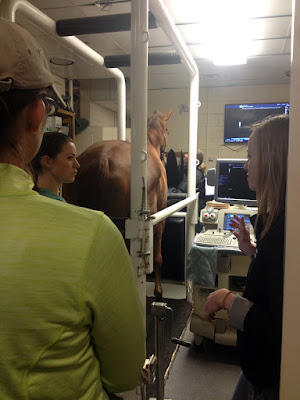As I've been working with Fason he has learned that I want him to do things differently than the way they are done on the track. I want him to stand quietly for mounting, I want him to reach his neck forwards and lift his back, tucking his pelvis beneath him to lengthen his entire topline. Here is a photo of one of my students with her horse and some arrows drawn in to show this lovely topline stretch.
Fason can't do this yet, but this is what we're aiming for. Fason is starting to understand that this is what I'm asking him to do, and he understands that I want him to stand still while I mount. However, he has really been struggling to do these things. Mounting has become so stressful for him that he will even trot in place anticipating me climbing on, and then try to burst forward once I'm aboard. Because I've taken the time to introduce these strange ideas to him carefully, I know that he understands what I want, but he has been sore and these particular things hurt. I also have noticed he is grumpy for grooming his haunches and back, and just seems painful. His right hip has been higher than his left as well, causing the back of my saddle to list to the left and exacerbate the problem.
I had my regular veterinarian come out and evaluate Fason, and he discovered Fason's pain is likely originating from his sacroiliac joint causing muscle pain throughout his haunches and back. He referred me to Colorado State University for a pelvic ultrasound to get a better look at what is going on inside Fason's sore behind.
Today was Fason's CSU appointment. We arrived a few minutes early, got checked in at the front desk, and then gave the head veterinary student the medical history. The students and then the attending veterinarian did brief physical exams, comparing notes to give the student a chance to develop her eye and fine tune her assessment. Fason was quite popular in the large intake bay area, his presence and height drew everyone's attention, then he won them over with his gentle demeanor.
After doing their cursory trot-out and exam for their records, the veterinarian and students concurred that we indeed needed to do a pelvic ultrasound to see if we could locate the source of Fason's pain. We adjourned to the ultrasound room, a small space for so many people, with large stocks in the center to restrain the horse.
The ultrasound veterinarians were wonderful, they carefully assessed all the various portions of Fason's anatomy from inside his body (they went in rectally) as well as externally by placing the ultrasound probe on top of his haunches.
The images showed that Fason has some bony changes in both his left and right sacroiliac joints. These are the parts of the body where the bottom of the vertebrae in the spine meet the pelvis. He also has an curious anatomical difference in a ligament on his left side, which is probably not clinically significant, but was interesting to appreciate on the ultrasound. These joint changes are a relatively common problem with the big english style horses, and the issues we found with the joints often respond very well to an injection of steroid to quiet the inflammation and pain killers to ease the discomfort.
We did inject Fason's SI joints, which is done by first sterilizing the area with some extensive scrubbing. One person even said they were sure they might just rub the orange right out of his coat!
Once the area has been cleaned and sterilized, the long needle is placed into the joint area guided by the image from the ultrasound probe. We got to watch on the screen as the needle was placed precisely in the right location, then the medications were injected through the needle.
We discussed Fason's prognosis, which is quite good. We of course need to watch and see how he responds to this treatment, but we should see some significant improvement anywhere from the first three days to two weeks. Ideally once his body has broken out of that pain and inflammation cycle and his core muscling is stronger to stabilize him, his body won't have such continued wear and tear on the SI joints. Some horses can have one of these injections and with proper rehabilitation such as what I do here at Bit of Honey Training they may never have a recurrence of the problem. I work with Equine Medical Services to provide acupuncture and manual therapy, Connective Touch Equine Massage for massage and kinesiotaping, and I do very careful and thorough physical therapy. Because of this the veterinarians were very positive about Fason's outlook towards getting comfortable and even going on to compete in eventing.
Fason was a champion (he enjoyed his sedative, too), and everyone just adored him. They ooo-ed and ahhh-ed at his track record of 78 starts, marveled at his $90,000 won in racing, and that he raced so long while staying sound. I discovered that the ultrasound veterinarians were big OTTB fans and they both said they would be cheering for us when we get to Kentucky in October for the makeover! It is great to have access to such good diagnostics like this ultrasound right here in town at CSU, and such a relief to know that the big guy still has a bright future ahead of him once we get him comfortable.















No comments:
Post a Comment